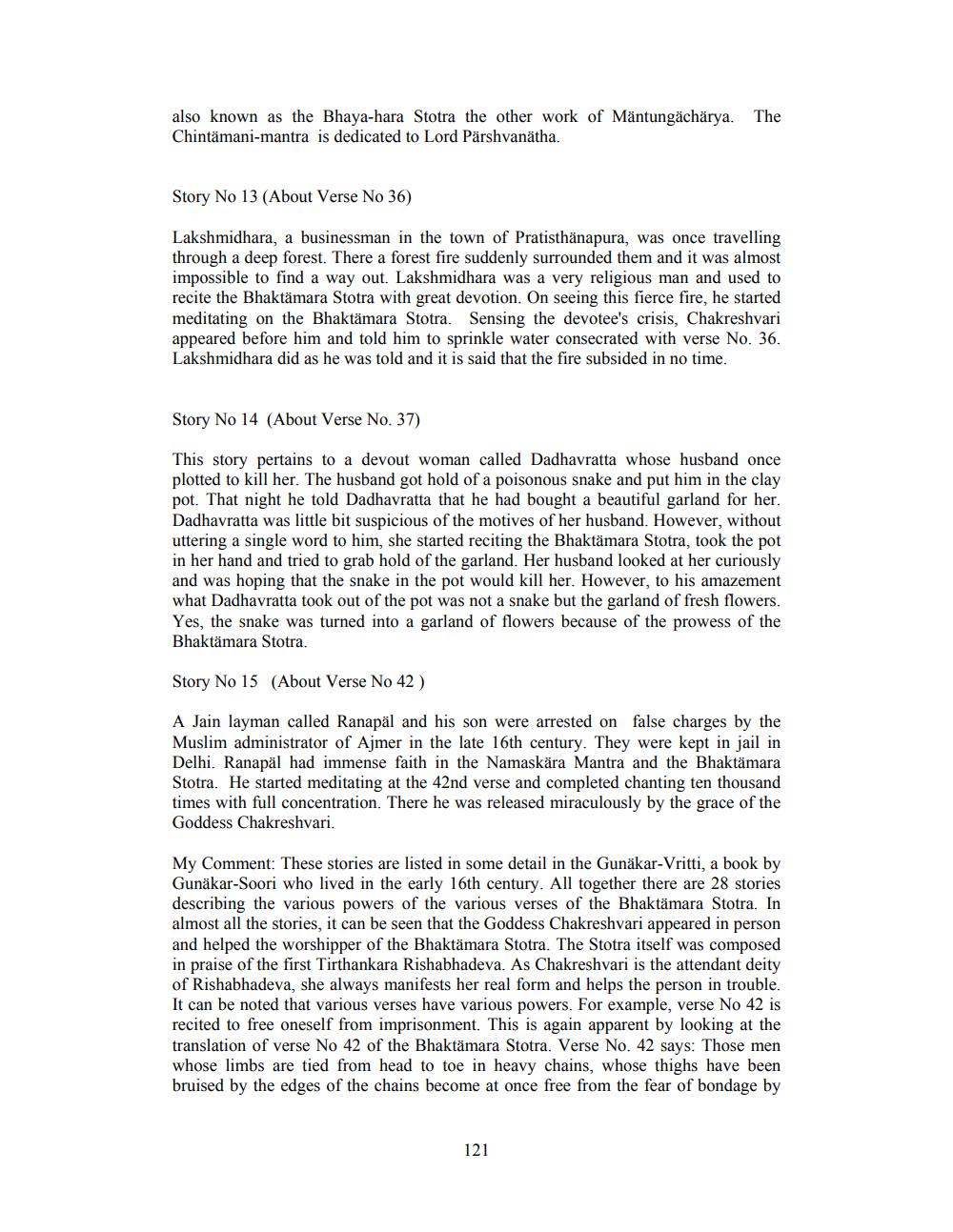________________
also known as the Bhaya-hara Stotra the other work of Mäntungächärya. Chintämani-mantra is dedicated to Lord Pärshvanatha.
The
Story No 13 (About Verse No 36)
Lakshmidhara, a businessman in the town of Pratisthänapura, was once travelling through a deep forest. There a forest fire suddenly surrounded them and it was almost impossible to find a way out. Lakshmidhara was a very religious man and used to recite the Bhaktämara Stotra with great devotion. On seeing this fierce fire, he started meditating on the Bhaktämara Stotra. Sensing the devotee's crisis, Chakreshvari appeared before him and told him to sprinkle water consecrated with verse No. 36. Lakshmidhara did as he was told and it is said that the fire subsided in no time.
Story No 14 (About Verse No. 37)
This story pertains to a devout woman called Dadhavratta whose husband once plotted to kill her. The husband got hold of a poisonous snake and put him in the clay pot. That night he told Dadhavratta that he had bought a beautiful garland for her. Dadhavratta was little bit suspicious of the motives of her husband. However, without uttering a single word to him, she started reciting the Bhaktămara Stotra, took the pot in her hand and tried to grab hold of the garland. Her husband looked at her curiously and was hoping that the snake in the pot would kill her. However, to his amazement what Dadhavratta took out of the pot was not a snake but the garland of fresh flowers. Yes, the snake was turned into a garland of flowers because of the prowess of the Bhaktämara Stotra.
Story No 15 (About Verse No 42 )
A Jain layman called Ranapäl and his son were arrested on false charges by the Muslim administrator of Ajmer in the late 16th century. They were kept in jail in Delhi. Ranapäl had immense faith in the Namaskära Mantra and the Bhaktämara Stotra. He started meditating at the 42nd verse and completed chanting ten thousand times with full concentration. There he was released miraculously by the grace of the Goddess Chakreshvari.
My Comment: These stories are listed in some detail in the Gunäkar-Vritti, a book by Gunäkar-Soori who lived in the early 16th century. All together there are 28 stories describing the various powers of the various verses of the Bhaktämara Stotra. In almost all the stories, it can be seen that the Goddess Chakreshvari appeared in person and helped the worshipper of the Bhaktämara Stotra. The Stotra itself was composed in praise of the first Tirthankara Rishabhadeva. As Chakreshvari is the attendant deity of Rishabhadeva, she always manifests her real form and helps the person in trouble. It can be noted that various verses have various powers. For example, verse No 42 is recited to free oneself from imprisonment. This is again apparent by looking at the translation of verse No 42 of the Bhaktämara Stotra. Verse No. 42 says: Those men whose limbs are tied from head to toe in heavy chains, whose thighs have been bruised by the edges of the chains become at once free from the fear of bondage by
121




